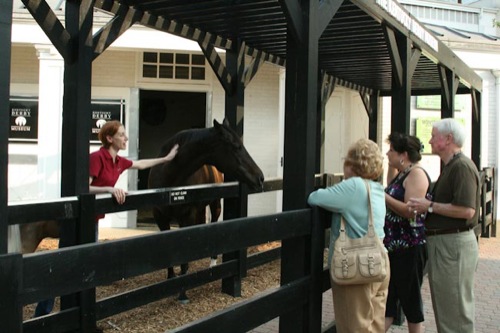
Courtesy Kentucky Derby Museum
Kentucky Derby Museum
Louisville, Kentucky
The first Saturday of every May, tens of thousands of people descend on Churchill Downs in Louisville, Kentucky, for the “fastest two minutes in sports”: the Kentucky Derby.
During the rest of the year, fans can visit the Kentucky Derby Museum to learn more about the longest continuously held sporting event in America.
“It’s the dream of many folks to see Churchill Downs, and the museum is the best way to see the track when they’re not racing,” said Wendy Treinen, director of marketing and communications.
The museum opened in 1985 on land donated by Churchill Downs. In August 2009, a flash flood destroyed many of the main floor exhibits, but the museum reopened in April 2010 after a $5.5 million renovation.
“The renovation brought us up to the times,” Treinen said. “It gave us the chance to push the envelope a little bit and be much more interactive.”
At the “Riders Up” exhibit, three people can mount model horses — that move — and try to maintain a jockey’s stance as they race one another. At the “Callers” exhibit, visitors step into a soundproof booth and try to call a race playing on a screen.
“It records you, so you can play it back for the amusement of your friends,” Treinen said.
Visitors also learn about the horses, the breeding process and what it’s like to be an owner, a jockey or even a dedicated fan. There’s even a hat exhibit.
General admission includes a 30-minute walking tour of the track facility. The museum also offers a Backstretch Breakfast tour for up to 48 people that starts with breakfast and is followed by a trip to the barn areas.
www.derbymuseum.org
The National WWII Museum
New Orleans, Louisiana
People may think they know the story of World War II, but after visiting the National WWII Museum in New Orleans guests are “always pretty blown away by the scope of the story,” said Andy Myer, museum director of marketing and communications.
“People come away with a sense of awe and inspiration after learning what these men and women did when they served our country,” Myer said. “A lot of people know about the war, but they may not know as much as they will when they leave here.”
The museum opened in June 2000, and Congress designated it the country’s national World War II museum in 2003. With more than 200,000 square feet and more than 100,000 artifacts, the museum’s mission is to tell the American experience in the war, convey what that means today and expand that to future generations, Myer said. The museum has several WWII veterans on staff who share their stories with guests, she added.
Many visitors enjoy “Beyond All Boundaries,” a 4-D movie experience designed to immerse viewers in the story of the war. The show includes rare historic footage and incorporates props that rise from the floor, descend from the ceiling or emerge from the screen. The seats even rumble with the appearance of tanks.
In January, the museum opened its new expansion, the $325 million U.S. Freedom Pavilion: The Boeing Center. In the Freedom Pavilion, visitors can see restored American fighter planes, bombers and other aircraft in the “Warbirds” exhibit or learn about ambulances, tanks and half-tracks in the “Vehicles of War” exhibit.










